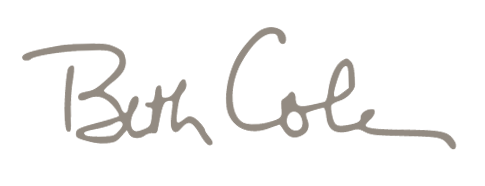Painting With Oils - Part Two
/Untitled, Oil on Canvas, 12 x 12 © Beth Cole
This is the second post in a series I am working on about oil painting. Here is the link to the first post.
Mixing Colors and Using Medium
This post is about mixing colors and using medium in your oil paint.
Nebraska artist Patty Scarborough had some great advice about mixing paint on her blog, she said (and I agree) the best way to learn how to mix colors is hands on experimentation – in other words - trial and error. There really is no substitute.
It is fun to mix colors, it can be addicting. It is especially fun to practice mixing warm and cool colors. This is something I have been learning and doing for the past few months and I believe it has made a big difference in my paintings.
When I first started painting with oil, I did not grasp the concept of temperature in painting, but I am starting to understand it, and it has made a big difference.
These are the basic warm and cool colors I use most often:
- Prussian Blue – Cool
- Ultramarine Blue – Warm
- Cad Yellow Light – Cool
- Yellow Ochre – Warm
- Alizarin Crimson – Cool
- Cad Red Light – Warm
- Titanium White
- Warm White
You might try mixing a warm and cool version of each color you want to use in your painting. It can add interest and sophistication to your work.
Now, what about using medium with oil paint?
When I first started my art journey I painted with acrylic and so I learned about using matte medium with the paint to extend it and make it more transparent. When I started transitioning to oil, I loved how buttery the paint was without any medium and I loved how long it would stay open so I could go back and make changes. I didn’t understand the concept of painting fat over lean, in other words using really thin paint to begin with, then building up the layers as you go. So, in order to paint lean you need to use some type of oil medium to thin the paint down.
There are plenty of choices when it comes to medium, I have tried walnut oil and solvent free gel by Gamblin. Walnut oil is nice because it is a natural oil, does not have an odor (unless it sits out too long and goes rancid, I have not experienced this but I read it is something to watch out for). To keep walnut oil longer, other artists recommend keeping it in the refrigerator.
Clove oil is another oil that I have tried and I really like it, but it is hard to find so I have only used it once in a workshop (Todd Williams – excellent). It is on my list to try again this year.
If I’m using walnut oil, before I begin a piece, I make sure I squeeze out new paint and add a few drops of walnut oil to each pile. Then I mix the oil in so it’s nice and fluffy, like frosting. I’m not sure if this is the best way to use walnut oil, but it has worked okay for me.
To use the solvent-free gel, I squeeze it onto the palette and mix as I begin painting. I try to mix all my colors before I ever start painting. This helps me keep a unified palette and make sure the colors go together. One instructor I had said, look at your palette and ask yourself if you would wear those colors together? If so, you are on the right track. I always think about this when I am mixing colors.
That’s about it, if you have any color mixing or oil medium tips to share, I would love to hear them, please do comment.
Next up, I will write about oil painting surfaces.
Thanks for reading along, I am grateful for you.
--Beth

